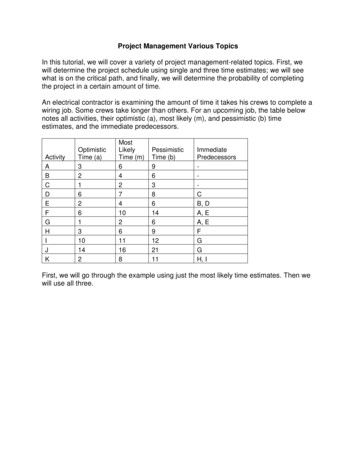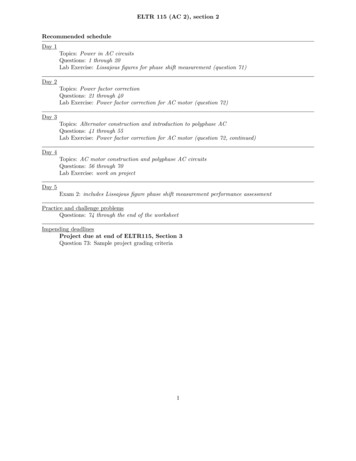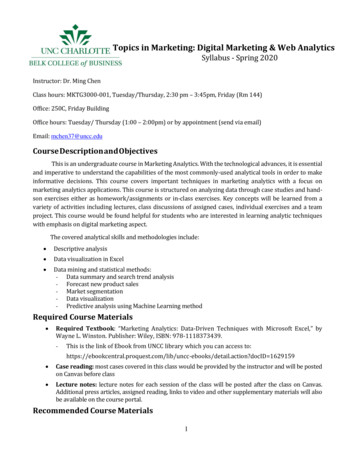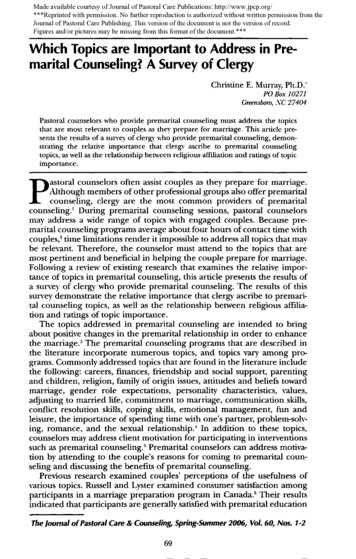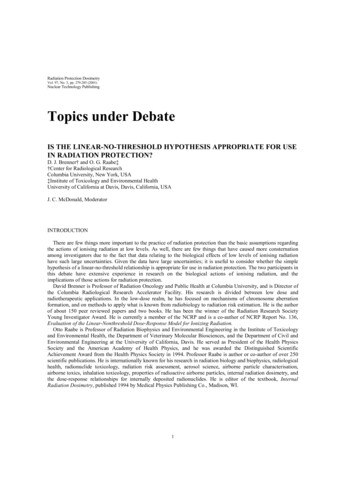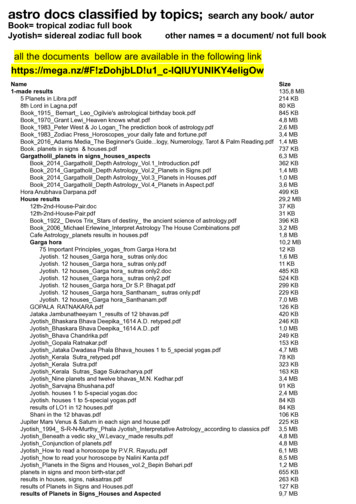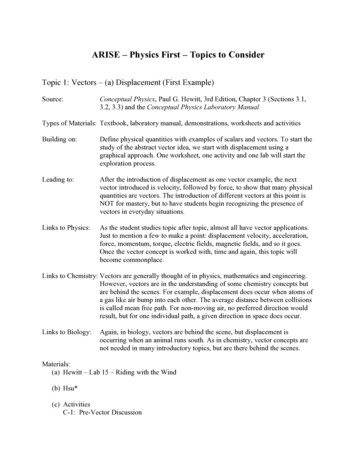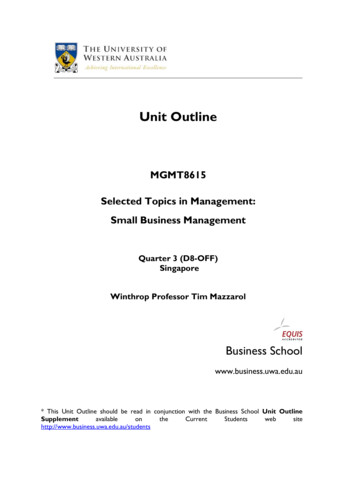
Transcription
Unit OutlineMGMT8615Selected Topics in Management:Small Business ManagementQuarter 3 (D8-OFF)SingaporeWinthrop Professor Tim MazzarolBusiness Schoolwww.business.uwa.edu.au* This Unit Outline should be read in conjunction with the Business School Unit itehttp://www.business.uwa.edu.au/students
MGMT8608 Crawley TM 21.11.09All material reproduced herein has been copied in accordance with and pursuant to a statutorylicence administered by Copyright Agency Limited (CAL), granted to the University of WesternAustralia pursuant to Part VB of the Copyright Act 1968 (Cth).Copying of this material by students, except for fair dealing purposes under the Copyright Act, isprohibited. For the purposes of this fair dealing exception, students should be aware that the ruleallowing copying, for fair dealing purposes, of 10% of the work, or one chapter/article, applies to theoriginal work from which the excerpt in this course material was taken, and not to the coursematerial itself. The University of Western Australia 20102
UNIT DESCRIPTIONIntroductionWelcome to Small Business Management, if you have chosen to undertake this unit you havesigned up to take a very different look at business management from what might have been taughtto you in other units.Small firms (those with less than 200 employees) comprise the majority of all businesses in theeconomies of most countries. For example, among the 21 countries that comprise the AsiaPacific Economic Cooperation (APEC) group of nations, small firms make up over 98% of allbusinesses, provide 60% of all private sector jobs and generate around 30% of direct exports.1The majority of such firms are very small (micro-enterprises) with less than five employees,usually just a single owner-manager. In the APEC region there are an estimated 50 million smallfirms of which 75% employ fewer than 5 people with the average employing around 6 to 7people.The reality of business management within the small firm is substantially different from that foundin the majority of large organizations. Owners-managers, as the name suggests, are both owners– and therefore responsible for all risks associated with their business ventures – and managers.Such individuals must deal with all the functional tasks of business management (such asaccounting, planning, marketing, human resources, production, information technology),frequently without much assistance and with limited training.The world of the average small business owner-manager is quite different from that of theprofessional manager within the large organization, or even the successful entrepreneur (e.g.Rupert Murdoch, Richard Branson, or Bill Gates).In Small Business Management, the start-up phase is confined to small businesses and we thenmove on to various issues of relevance to successfully managing the small business. Like someother MBA units, Small Business Management integrates the various disciplines of business andmanagement. We will assume that MBA students already have a background in finance,accounting, marketing, leadership and related skills associated with running a business. We shallfocus on how these topics are applied to small business management.In addition to lectures on theory and case study discussions, the course has a strong practicalorientation with relevance to present day real life situations. Students will interview ownermanagers of small businesses and report their findings. We shall also invite a number of ownermanagers and other speakers on small business management to class to hear their views.Students will research special topics, test the validity of textbook material against experience andpresent their findings to the class.Your Lecturer – Professor Tim MazzarolTim Mazzarol is a Winthrop Professor within the UWA Business School where he specialises inentrepreneurship, innovation, small business management, strategy and marketing. He is also anaffiliate professor at the Burgundy School of Business, Groupe ESC Dijon Bourgogne, France. Timjoined UWA in 2001 and was the founder Director of the Centre for EntrepreneurialManagement and Innovation (CEMI) from 2003 to 2007, then Director of Doctoral Programs at1APEC (2002) Profile of SMEs and SME Issues in APEC 1990-2000, Singapore, APEC Secretariat, WorldScientific Publishing.3
the Business School from 2008 to 2009. Prior to joining UWA he was at Curtin University from1994 to 2000 where he was a Research Fellow with the Institute for Research into InternationalCompetitiveness (IRIC) and Executive Director of the Small Business Unit.He has published widely in the field of entrepreneurship, innovation and small businessmanagement including several books such as The Strategy of Small Firms: Strategic Management andInnovation in the Small Firm, Entrepreneurship and Innovation: A Manager’s Perspective; and SmallBusiness Management: an Applied Approach. He has worked with small entrepreneurial firms as wellas large corporations and government agencies. This has included strategic management,marketing and support to commercialization. Tim has also designed several innovative courses instrategic management, marketing, entrepreneurship, innovation and small business managementfor both MBA level programs and industry professional development.He has undertaken over 100 projects in the areas of market research and economic orcommunity studies for government and industry clients including the Government of Canada,RAC, Bank of Western Australia, LandCorp, City of Belmont, Australian Education International,State West Credit Society, WA Potato Marketing Board, TimberCorp Ltd, CSIRO, Departmentof Land Administration, LandCorp, Agriculture Department of Western Australia, EasternMetropolitan Regional Council, Small Business Development Corporation, WA Department ofIndustry and Resources, WA Department of Education and Training, Wesfarmers Ltd, WaterCorporation, WA Football League, WA Trotting Association, Racing and Wagering WA andNokia.Prior to taking up an academic career Tim served with the Australian diplomatic service includinga posting to Bangkok during the late 1980s, and as a sales manager with National Mutual Ltd. Heis a shareholder and non-executive director for two small companies and consults widely to bothindustry and government. Tim has authored two text books on small business andentrepreneurship and innovation. He holds a PhD in Management and an MBA with distinctionfrom Curtin University of Technology, and a Bachelor of Arts with Honours from MurdochUniversity, Western Australia.Unit contentThis unit concentrates on the management of small business and the aspects of coping withsurvival and growth of small and medium-sized businesses. Topics covered, include the role ofsmall business in the economy; starting a small business; management challenges of running asmall business; critical stages of growth; alternative modes of growth; the small businessconglomerate; advising small businesses; franchising; family businesses; succession problems andsmall business strategies. Students relate case studies of small businesses with theory andundertake a substantial practical assignment, which includes interviews with owner-managers.The Goal of the unitThe principal aim of this unit is to familiarize students with the theory and practice of smallbusiness management and challenge assumptions that may be held about the way small businessmanagement can or should adopt large business practice models. For students interested inestablishing and managing their own small firms, this unit should help to focus their thinking onthe realities of life as a small business owner-manager – both its challenges and rewards. For MBAstudents who are keen to ‘make a difference’, this unit should enable them understand how theymight consult to small firms and assist owner-managers establish and grow their ventures.Students with a range of other interests will also benefit from the course. Managers in largecorporations and financial institutions often deal with small businesses as clients or suppliers.Professionals such as accountants, lawyers and consultants often provide advice and other4
services to small businesses. Government officials devise and implement policies, regulations andsupport programs that will affect the small business sector. A good understanding of the topiccan assist such individuals in their work.Learning outcomesOn completion of this unit, you should be able to: Distinguish between the ‘managerial environment’ facing an owner-manager of a smallbusiness and that of a manager working within a large organization. Differentiate the roles, perspectives and characteristics of ‘owner-managers’ versus‘entrepreneurs’. Apply the new venture creation process relating to small businesses and effectivelyreview other models of new venture creation. Determine the key legal issues facing small businesses and how they impact onoperations. Recognize the common problems facing small businesses in their early years, withemphasis on opportunity screening and financial management. Apply strategic planning principles in developing and managing small businesses. Examine competently the financial opportunities for small business owners seekinggrowth, with particular emphasis on bootstrap financing, retained profits, andnegotiation with banks. Undertake an evaluation of a small business and prepare a growth strategy for thebusiness. Develop a human resource strategy for a small business, including plans for effectivedelegation, team building and coaching. Evaluate franchising as a business model and understand its advantages anddisadvantages. Consider the nature of family-owned and operated businesses and the importance ofsuccession planning. Troubleshoot problems within small businesses and prepare a turnaround strategy. Prepare a valuation of a small business, including goodwill, and confidently undertakethe process to put it for sale.Educational Principles and Graduate AttributesIn this unit, you will be encouraged and facilitated to develop the ability and desire to:1. Define the role of entrepreneurs and small businesses in the Australian economy anddescribe the benefits and potential drawbacks of owning a small business.2. Explain why and how a small business must create a competitive advantage in themarket.3. Evaluate the different forms of small business ownership.4. Describe and develop the key elements of a solid small business plan.5. Explain how to build a company culture and structure that will support the smallbusiness owner-managers mission and goals and motivate employees to achieve them.Interpret the key legal issues facing small businesses and how they impact on operations.5
TEACHING AND LEARNING RESPONSIBILITIESTeaching and learning strategiesLearning any subject requires substantial input from both the teacher and student, with thebalance of effort significantly weighted toward you the student. It is hoped that students whoundertake this unit will find it enjoyable, challenging and intellectually stimulating. The focus oflearning within the unit will be upon investigation and analysis, making use of case studies, smallgroup discussion and reporting. Lectures will be held to provide a structural framework,however, there will be a strong emphasis placed upon group learning and student participation.The pyramid outlined in Figure 1 below best represents the teaching philosophy behind this unit.As can be seen, the most effective learning takes place when students are required to apply theirlearning or teach others.Learning StylesLEARNING PYRAMIDAVERAGERETENTION n30%Discussion GroupPractice by doingTeach others/Immediate use of Learning50%75%90%National Training LaboratoriesBETHEL, MAINEFigure 1: A Learning Retention Model for EducationThe learning model outlined in Figure 1 suggests that you will not get the most out of this unit ifall you do is attend the weekly lecture and listen passively. As good as your lecturer might be,you cannot expect to really benefit from this unit unless you are prepared to read the text andother materials provided, listen to and question the guest speakers, participate in the classdiscussions and apply your knowledge within the assignments. The design of this unit aims toprovide you with all these elements, including assisting an entrepreneur seeking to introduce anew innovation, where you can practice by doing and teach others the things you have learnt.Teaching and learning evaluationYou may be asked to complete two evaluations during this unit: i) the Student Perception ofTeaching (SPOT); and ii) the Students’ Unit Reflective Feedback (SURF). The SPOT is optionaland is an evaluation of the lecturer and the unit. The SURF is completed online and is a universitywide survey and deals only with the unit. You will receive an email from the SURF office invitingyou to complete the SURF when it is activated. We encourage you to complete the forms asyour feedback is extremely important and can be used to make changes to the unit or lecturingstyle when appropriate.6
AttendanceParticipation in class, whether it is listening to a lecture or getting involved in other activities, isan important part of the learning process. It is therefore important that you attend classes. Moreformally, the University regulations state that ‘to complete a course or unit students shall attendprescribed classes, lectures, seminars and tutorials’. Students should not expect to obtainapproval to miss more than two classes per unit unless there are exceptional circumstances.CONTACT DETAILSWe strongly advise students to regularly access their student email accounts. Importantinformation regarding the unit is often communicated by email and will not be automaticallyforwarded to private email addresses.Unit coordinator/lecturerName:Winthrop Professor Tim MazzarolEmail:tim.mazzarol@uwa.edu.auPho
Welcome to Small Business Management, if you have chosen to undertake this unit you have signed up to take a very different look at business management from what might have been taught to you in other units. Small firms (those with less than 200 employees) comprise the majority of all businesses in the economies of most countries. For example, among the 21 countries that comprise the Asia .

